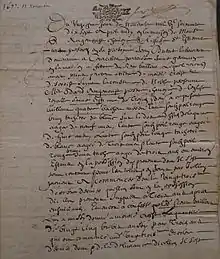Papier timbré
In ancien regime France, papier timbré (French pronunciation: [papje tɛ̃bʁe], stamped paper) was paper with a special revenue stamp that was compulsory for all authentic acts (i.e., documents used in law, such as wills, sale contracts and vital records).[1] The tax on it, known as the timbre fiscal fixe or entier fiscal (sometimes also known as the papier timbré tax as a metonym), was one of the two forms of the timbre fiscal (the other was the timbre fiscal mobile).

Stamp on paper : Papier timbre
The Revolt of the papier timbré in 17th century Brittany arose from resistance to the papier timbré tax.
See also
References
- Devaux, Alexandre (1911). Papiers et parchemins timbrés de France.
This article is issued from Wikipedia. The text is licensed under Creative Commons - Attribution - Sharealike. Additional terms may apply for the media files.